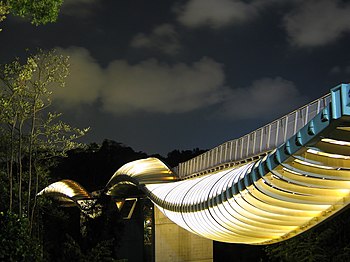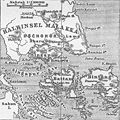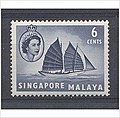Portal:Singapore
 Map of Singapore Singapore, officially the Republic of Singapore, is an island country and city-state in Southeast Asia. The country's territory comprises one main island, 63 satellite islands and islets, and one outlying islet. It is about one degree of latitude (137 kilometres or 85 miles) north of the equator, off the southern tip of the Malay Peninsula, bordering the Strait of Malacca to the west, the Singapore Strait to the south along with the Riau Islands in Indonesia, the South China Sea to the east, and the Straits of Johor along with the State of Johor in Malaysia to the north.
Singapore's history dates back at least eight hundred years, having been a maritime emporium known as Temasek and subsequently a major constituent part of several successive thalassocratic empires. Its contemporary era began in 1819, when Stamford Raffles established Singapore as an entrepôt trading post of the British Empire. In 1867, Singapore came under the direct control of Britain as part of the Straits Settlements. During World War II, Singapore was occupied by Japan in 1942 and returned to British control as a separate Crown colony following Japan's surrender in 1945. Singapore gained self-governance in 1959 and, in 1963, became part of the new federation of Malaysia, alongside Malaya, North Borneo, and Sarawak. Ideological differences led to Singapore's expulsion from the federation two years later; Singapore became an independent sovereign country in 1965. After early years of turbulence and despite lacking natural resources and a hinterland, the nation rapidly developed to become one of the Four Asian Tigers. As a highly developed country, it has one of the highest GDP per capita (PPP) in the world. It is also identified as a tax haven. Singapore is the only country in Asia with a AAA sovereign credit rating from all major rating agencies. It is a major aviation, financial, and maritime shipping hub and has consistently been ranked as one of the most expensive cities to live in for expatriates and foreign workers. Singapore ranks highly in key social indicators: education, healthcare, quality of life, personal safety, infrastructure, and housing, with a home-ownership rate of 88 percent. Singaporeans enjoy one of the longest life expectancies, fastest Internet connection speeds, lowest infant mortality rates, and lowest levels of corruption in the world. It has the third highest population density of any country in the world, although there are numerous green and recreational spaces as a result of urban planning. With a multicultural population and in recognition of the cultural identities of the major ethnic groups within the nation, Singapore has four official languages: English, Malay, Mandarin, and Tamil. English is the common language, with exclusive use in numerous public services. Multi-racialism is enshrined in the constitution and continues to shape national policies in education, housing, and politics. Singapore is a parliamentary republic in the Westminster tradition of unicameral parliamentary government, and its legal system is based on common law. While the country is de jure a multi-party democracy with free elections, the government under the People's Action Party (PAP) wields widespread control and political dominance. The PAP has governed the country continuously since full internal self-government was achieved in 1959, and holds a supermajority in Parliament. One of the five founding members of ASEAN, Singapore is also the headquarters of the Asia-Pacific Economic Cooperation Secretariat, the Pacific Economic Cooperation Council Secretariat, and is the host city of many international conferences and events. Singapore is also a member of the United Nations, the World Trade Organization, the East Asia Summit, the Non-Aligned Movement, and the Commonwealth of Nations. (Full article...)Selected article - The Singapore Stone is a fragment of a large sandstone slab which originally stood at the mouth of the Singapore River. The large slab, which is believed to date back to at least the 13th century and possibly as early as the 10th or 11th century, bore an undeciphered inscription. Recent theories suggest that the inscription is either in Old Javanese or in Sanskrit, which suggested a possibility that the island was an extension of the Majapahit civilization in the past. It is likely that the person who commissioned the inscription was Sumatran. The slab may be linked to the legendary story of the 14th-century strongman Badang, who is said to have thrown a massive stone to the mouth of the Singapore River. On Badang's death, the Rajah sent two stone pillars to be raised over his grave "at the point of the straits of Singapura". (Full article...) Selected picture Henderson Waves, a 274-metre (900-foot) long pedestrian bridge connecting Mount Faber Park and Telok Blangah Hill Park. At 36 metres (120 feet) above Henderson Road, it is the highest pedestrian bridge in Singapore. Read more... General imagesThe following are images from various Singapore-related articles on Wikipedia.
Selected biography -Ho Yuen Hoe (simplified Chinese: 何润好; traditional Chinese: 何潤好; pinyin: Hé Rùnhǎo; 18 February 1908 – 11 January 2006), later in life but rarely known by her Dharma name, Venerable Jing Run (simplified Chinese: 净润法师; traditional Chinese: 淨潤法師; pinyin: Jìngrùn Fǎshī), was a Buddhist nun affectionately known as Singapore's "grand dame of charity" in recognition of her lifelong devotion in helping the old and needy. She was the abbess of Lin Chee Cheng Sia Temple and the founder in 1969 of the Man Fut Tong Nursing Home, the first Buddhist nursing home. Venerable Ho was relatively unknown to the public until 1996, when she was featured in a television programme – The Extraordinary People – at the age of 88. As a result, the public became more familiar with her work and her nursing home. In 2001, she received the Public Service Award from the President of Singapore in recognition of her contribution to the country. Until her hospitalisation in November 2005 she was actively involved in charity work. Venerable Ho died on 11 January 2006, a month before what would have been her 98th birthday. (Full article...) Did you know (auto-generated)
In this month
More did you know -
Selected panoramaJurong Island is a man-made island located to the southwest of the main island of Singapore, off Jurong Industrial Estate. It was formed from the amalgamation of several offshore islands, chiefly the seven main islands of Pulau Ayer Chawan, Pulau Ayer Merbau, Pulau Merlimau, Pulau Pesek, Pulau Pesek Kecil, Pulau Sakra and Pulau Seraya. Singapore topicsRelated portalsSoutheast Asia Other Countries Tasks
CategoriesWikiprojectsAssociated WikimediaThe following Wikimedia Foundation sister projects provide more on this subject:
Discover Wikipedia using portals |






























































